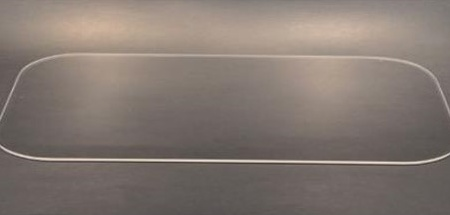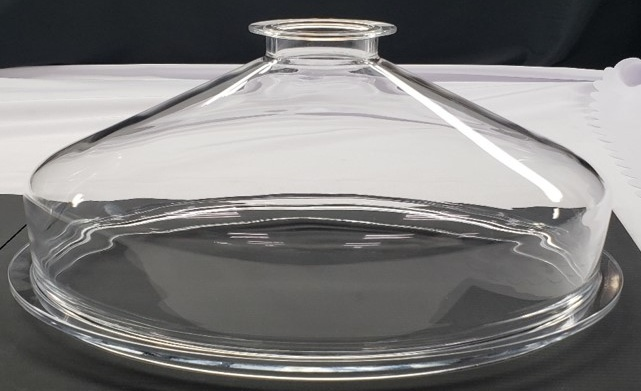Quartz glass is a special industrial technical glass composed of a single component of silica. It has a series of excellent properties unparalleled by ordinary glass. It is praised as the “King of Glass” by experts in the field of new materials. , semiconductors and other national strategic emerging industries and important basic materials in the aerospace and other defense fields.
1 Structural characteristics of quartz glass
Pure quartz glass is composed of a single component of silicon dioxide (SiO2). The Si-O bonds in quartz glass are arranged in short-range order and long-range disorder. Because the bond energy of Si-O bonds is strong and relatively stable, Therefore, quartz glass has the characteristics of high softening temperature, excellent spectral transmittance, extremely low thermal expansion coefficient and electrical conductivity, extremely high chemical stability, radiation resistance and long working life under extreme conditions. .

2 Properties and applications of quartz glass
(1) Optical properties
Quartz glass has a range of excellent optical properties. Compared with ordinary glass, high-purity quartz glass has good transmittance in a very wide spectrum from far ultraviolet (160nm) to far infrared (5μm), which is not available in general optical glass. Excellent spectral transmittance and optical uniformity make quartz glass widely used in semiconductor lithography and precision optical devices.
In addition, quartz glass has good radiation resistance, and radiation-resistant quartz glass has been widely used as the window material of the “Shenzhou” series of spacecraft, and the protective cover of the key components of the “Tiangong” series of space laboratories.

(2) Mechanical properties
Quartz glass is similar to ordinary glass and is a brittle and hard material. Like ordinary glass, the strength parameters of quartz glass are affected by many factors, including surface state, geometry, and testing methods. The compressive strength of transparent quartz glass is generally 490~1960MPa, the tensile strength is 50~70MPa, the flexural strength is 66~108MPa, and the torsional strength is about 30MPa.
(3) Electrical properties
Quartz glass is an excellent electrical insulating material. Compared with ordinary glass, quartz glass has higher resistivity, and the resistivity of quartz glass at room temperature is as high as 1.8×1019Ω∙cm. In addition, quartz glass has a higher breakdown voltage (about 20 times that of ordinary glass) and lower dielectric loss. The resistivity of quartz glass decreases slightly with increasing temperature, and the resistivity of opaque quartz glass is lower than that of transparent quartz glass.
(4) Thermal properties
Since almost all the inside of quartz glass is a strong Si-O bond, its softening temperature is very high, and the long-term working temperature can reach 1000 °C. In addition, the thermal expansion coefficient of quartz glass is the lowest among common industrial glasses, and its linear expansion coefficient can reach 5×10-7/℃, and the specially treated quartz glass can even reach zero expansion. Quartz glass also has very good thermal shock resistance, even if it is repeatedly subjected to extreme temperature differences in a short period of time, it will not crack. These excellent thermal properties make quartz glass irreplaceable by other glasses in high temperature and extreme working environments.
High-purity quartz glass can be used in chip manufacturing in the semiconductor industry, auxiliary materials for optical fiber manufacturing, observation windows in industrial high-temperature furnaces, high-power electric light sources, and as a thermal insulation layer on the surface of space shuttles. The extremely low coefficient of thermal expansion also enables quartz glass to be used in precision instruments, lens materials for large astronomical telescopes, etc.
(5) Chemical properties
The chemical stability of quartz glass is very good. Unlike other commercial glasses, quartz glass has extremely high chemical stability to water, so it can be used in water stills that require extremely high purity of water. Quartz glass has excellent acid and salt resistance, and does not react with most acids and salt solutions except for hydrofluoric acid, phosphoric acid and alkaline salt solutions. Compared with acid and salt solutions, quartz glass has poor alkali resistance and will react with alkali solutions at high temperatures. In addition, quartz glass and most oxides, metals, non-metals and gases do not react at normal temperatures. The extremely high purity and good chemical stability allow quartz glass to be used in semiconductor manufacturing and other environments that require high production conditions.

3 Quartz glass preparation method
The preparation methods of quartz glass can be divided into two categories. The first type is obtained by melting natural quartz crystal or silica as raw material, which is called natural quartz glass. The first type of method can be subdivided into electrofusion method, gas smelting method, plasma fusion method, etc. according to the different heat sources and processes. The second type is synthesized by chemical reaction of silicon-containing compounds (including silicon halide, silicon hydride and organic silicon, etc.) as raw materials, which is called synthetic quartz glass. The second type of method can be divided into: plasma Chemical vapor deposition (PCVD), flame hydrolysis deposition (FHD), sol-gel method.
The preparation of high-purity quartz glass ingots by two-step chemical vapor deposition (CVD) method is a new technology developed in China in recent years. Therefore, it has broad development prospects. However, the two-step CVD method still faces a series of technical challenges, mainly manifested in the immature preparation process and insufficient understanding of the key scientific issues in the preparation process, which limit it to become the mainstream technology for the preparation of quartz glass in the industry. In addition, the quartz glass preparation industry still has problems such as glass bubble defects and difficult to control the thermal modification process of the product, resulting in the quality of the quartz glass cannot be effectively guaranteed.
